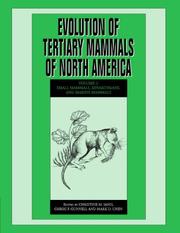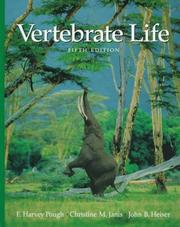| Listing 1 - 9 of 9 |
Sort by
|
Book
ISBN: 0131278363 9780131278363 Year: 2005 Publisher: Upper Saddle River, N.J. Pearson
Abstract | Keywords | Export | Availability | Bookmark
 Loading...
Loading...Choose an application
- Reference Manager
- EndNote
- RefWorks (Direct export to RefWorks)
Vertebrates --- Vertebrates. --- Vertebrates, Fossil. --- Vertébrés --- Vertébrés, Fossiles --- 596 --- Vertebrata. Vertebrates in general --- Vertébrés fossiles --- 596 Vertebrata. Vertebrates in general --- Vertébrés --- Vertébrés fossiles

ISBN: 9780511541438 9780521781176 9780511409967 0511409966 0511541430 0521781175 1281717134 9781281717139 1107174082 9786611717131 0511409427 0511408064 0511407327 0511408870 9781107174085 6611717137 9780511409424 9780511408069 9780511407321 9780511408878 Year: 2008 Publisher: Cambridge : Cambridge University Press,
Abstract | Keywords | Export | Availability | Bookmark
 Loading...
Loading...Choose an application
- Reference Manager
- EndNote
- RefWorks (Direct export to RefWorks)
This second volume completes the unique survey of North American Tertiary mammals, and covers all the remaining taxa not contained in Volume 1. It provides a complete listing of mammalian diversity over time and space, and evaluates the effect of biogeography and climatic change on evolutionary patterns and faunal transitions, with the distribution in time and space of each taxon laid out in a standardized format. It contains six summary chapters that integrate systematic and biogeographic information for higher taxa, and provides a detailed account of the patterns of occurrence for different species at hundreds of different fossil localities, with the inclusion of many more localities than were contained in the first volume. With over thirty chapters, each written by leading authorities, and an addendum that updates the occurrence and systematics of all of the groups covered in Volume 1, this will be a valuable reference for paleontologists and zoologists.
Mammals, Fossil --- Paleontology --- Animals, Fossil --- Evolutionary paleobiology. --- Evolutionary palaeobiology --- Evolution (Biology) --- Paleobiology --- Animal fossils --- Animals, Antediluvian --- Animals, Prehistoric --- Antediluvian animals --- Fauna, Prehistoric --- Prehistoric animals --- Prehistoric fauna --- Fossils --- Tertiary Period --- Amniotes, Fossil --- Vertebrates, Fossil

ISBN: 0136717691 Year: 1999 Publisher: Upper Saddle River, N.J. : Prentice Hall,
Abstract | Keywords | Export | Availability | Bookmark
 Loading...
Loading...Choose an application
- Reference Manager
- EndNote
- RefWorks (Direct export to RefWorks)
Vertebrates. --- Vertebrates, Fossil. --- Vertébrés --- Vertébrés fossiles
Book
ISBN: 9780321773364 Year: 2013 Publisher: Boston : Pearson,
Abstract | Keywords | Export | Availability | Bookmark
 Loading...
Loading...Choose an application
- Reference Manager
- EndNote
- RefWorks (Direct export to RefWorks)
Vertebrates --- Vertebrates, Fossil --- Vertébrés --- Vertébrés fossiles
Book
ISBN: 9781605356075 1605356077 Year: 2019 Publisher: New York Sinauer Associates, Oxford University Press
Abstract | Keywords | Export | Availability | Bookmark
 Loading...
Loading...Choose an application
- Reference Manager
- EndNote
- RefWorks (Direct export to RefWorks)
1. Evolution, diversity, and classification of vertebrates -- 2. What is a vertebrate? -- 3. Jawless vertebrates and the origin of jawed vertebrates -- 4. Living in water -- 5. Geography and ecology of the Paleozoic era -- 6. Radiation of diversification of chondrichthyes -- 7. Extant chondrichthyans -- 8. Radiation and diversity of osteichthyes -- 9. Extant bony fishes -- 10. Origin and radiation of tetrapods -- 11. Extant amphibians -- 12. Living on land -- 13. Geography and ecology of the Mesozoic Era -- 14. Synapsids and sauropsids -- 15. Ectothermy : a low-energy approach to life -- 16. Turtles -- 17. Lepidosaurs -- 18. Crocodylians -- 19. Mesozoic diapsids : dinosaurs and others -- 20. Endothermy: a high-energy approach to life -- 21. The origin and radiation of birds -- 22. Extant birds -- 23. Geography and ecology of the Cenozoic Era -- 24. Synapsida and the evolution of mammals -- 25. Extant mammals -- 26. Primate evolution and the emergence of humans.
Book
ISBN: 9780321782359 Year: 2013 Publisher: Boston Pearson
Abstract | Keywords | Export | Availability | Bookmark
 Loading...
Loading...Choose an application
- Reference Manager
- EndNote
- RefWorks (Direct export to RefWorks)
Book
ISBN: 0521255192 Year: 1998 Publisher: Cambridge University Press
Abstract | Keywords | Export | Availability | Bookmark
 Loading...
Loading...Choose an application
- Reference Manager
- EndNote
- RefWorks (Direct export to RefWorks)
Article
Abstract | Keywords | Export | Availability | Bookmark
 Loading...
Loading...Choose an application
- Reference Manager
- EndNote
- RefWorks (Direct export to RefWorks)
Multi
ISBN: 9783031174919 9783031174902 9783031174926 9783031174933 Year: 2023 Publisher: Cham Springer International Publishing :Imprint: Springer
Abstract | Keywords | Export | Availability | Bookmark
 Loading...
Loading...Choose an application
- Reference Manager
- EndNote
- RefWorks (Direct export to RefWorks)
This volume presents an array of different case studies which take as primary material data sourced from the NOW ('New and Old Worlds') database of fossil mammals. The NOW database was one of the very first large paleobiological databases, and since 1996 it has been expanded from including mainly Neogene European land mammals to cover the entire Cenozoic at a global scale. In the last two decades the number of works that are based in the use of huge databases to explore ecological and evolutionary questions has increased exponentially, and even though the importance of big data in paleobiological research has been outlined in selected chapters of general works, no volume has appeared before this one which solely focuses on the databases as a primary source in reconstructing the past. The purpose of this book is to provide an illustrative volume showing the importance of big data in paleobiological research, and presenting a broad array of unpublished examples and case studies. The book is mainly aimed to professional palaeobiologists working with Cenozoic land mammals, but the scope of the book is broad enough to fit the interest for evolutionary biologists, paleoclimatologists and paleoecologists. The volume is divided in four parts. The first part includes two chapters on the development of large paleobiological databases, providing a first-hand account on the logic and the functioning of these databases. This is a much-needed perspective which is ignored by most researchers and users of such databases and, even if centered in the NOW database, the lessons that can be learned from this part can be extended to other examples. After this introductory part, the body of the book follows and is divided into three parts: patterns in regional faunas; large scale patterns and processes; and ecological, biogeographical and evolutionary patterns of key taxa. Each chapter is written by well-known specialists in the field, with some participation of members of the NOW advisory board. The array of selected mammal taxa ranges from carnivores, equids, ruminants and rodents to the genusHomo. The topics studied also include the diversification and radiation of major clades, large-scale paleobiogeographical patterns, the evolution of ecomorphological patterns and paleobiological problems such as evolution of body size or species longevity. In most cases the results are discussed in relation to protracted environmental or paleogeographic changes.
Geology. Earth sciences --- General palaeontology --- Biomathematics. Biometry. Biostatistics --- Biological techniques --- General ecology and biosociology --- Physical geography --- bio-informatica --- biologie --- ecologie --- geologie --- fysische geografie --- aarde (astronomie) --- paleontologie --- Geology, Stratigraphic --- Cénozoïque. --- Fossils. --- Fossiles. --- Paleontology. --- Paléontologie. --- Cénozoïque. --- Paléontologie.
| Listing 1 - 9 of 9 |
Sort by
|

 Search
Search Feedback
Feedback About UniCat
About UniCat  Help
Help News
News